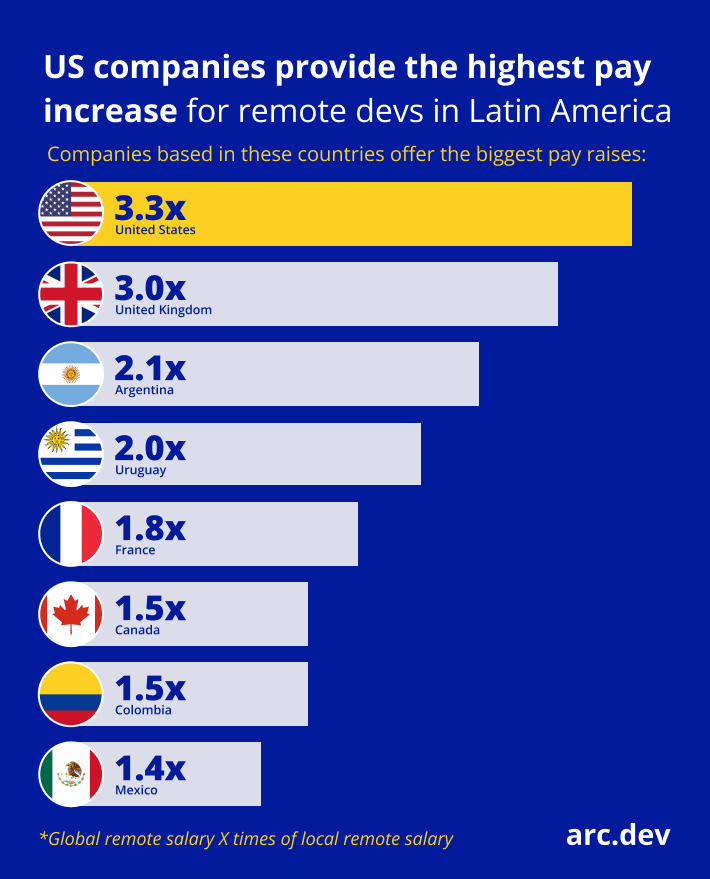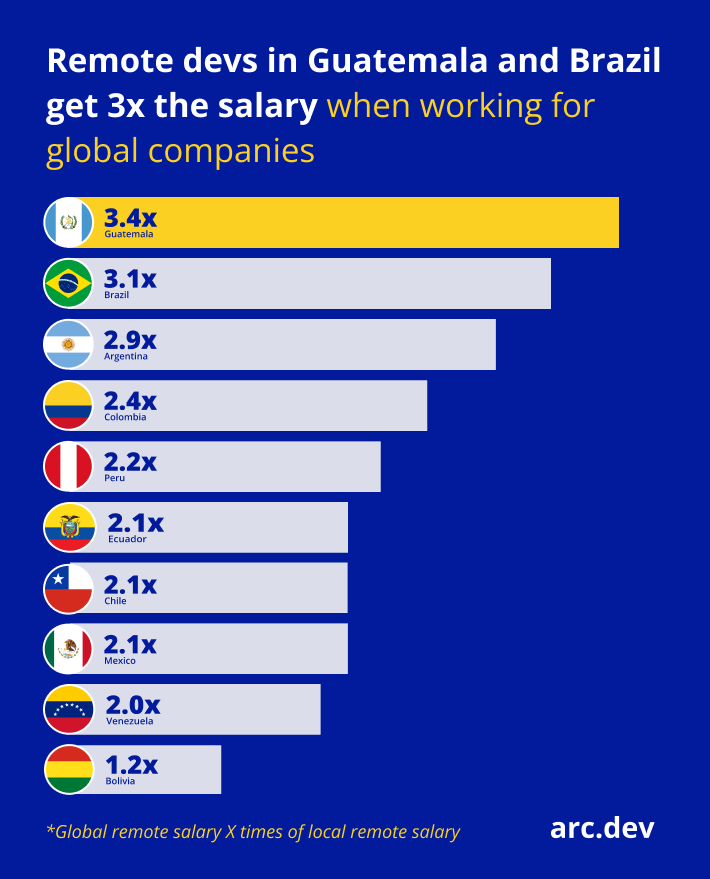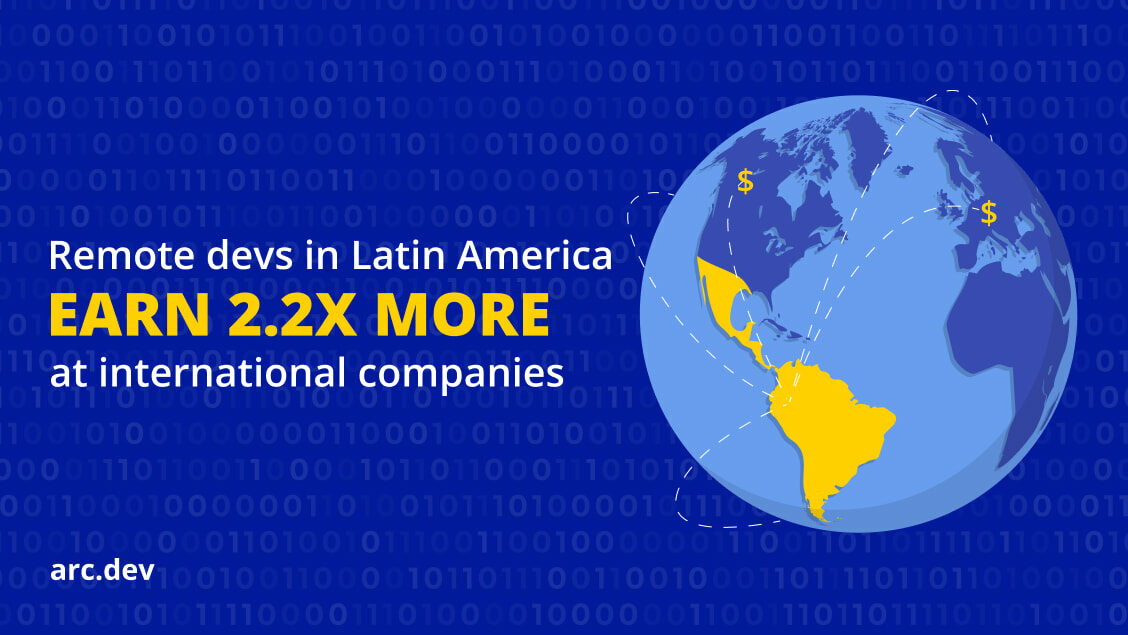International companies pay Latin-America-based remote software developers 2.2 times remote local salaries in 2022, a recent Arc survey shows. Depending on a developer’s base country, the number of years of experience, and employer country, this number can go even higher, up to 4X.
That’s per responses from 1,354 remote software developers in Latin America. Here’s what the analysis shows:
- The median annual salary for remote Latin American software developers working for local companies is $12,000, while those working internationally earn $26,400 (all data is in USD). For the 64% of developers working remotely for a US-based company, the median wage is $40,000.
- International companies pay remote Latin American senior developers with 6+ years of experience an annual median salary of $46,500 — or 2.1 times the local salary of $22,350. Working for US employers, the senior developer median salary is $60,000, or 2.7 times local remote pay, which is the median wage offered by local companies to remote developers.
- Junior or mid-level developers receive a median 1.6 times jump in income, from $9,600 (domestic employer) to $15,600 (international employer).
Looking to hire the best remote developers? Arc can help you:
⚡️ Get instant candidate matches without searching
⚡️ Identify top applicants from our network of 350,000+
⚡️ Hire 4x faster with vetted candidates (qualified and interview-ready)
Try Arc to hire top developers now →
US companies offer the highest salary

Compared to the median domestic salary in Latin America, US employers provide the biggest jump in income at 3.3X, followed by UK companies at 3X. These nations may snatch top talent from Latin America by paying above market rates.
Argentinian-headquartered companies also pay high international salaries, at 2X the Latin America local rates — possibly to attract and retain better quality international talent from other countries within Latin America.
- Employer countries paying the highest median compensation for a remote Latin American employee are the US and the UK at $40,000 and $36,000 respectively. They are followed by Argentina — hiring remote employees from other countries in the region — paying a median of $25,100.
Interesting to note that employers in Spain, where the average salary for a software developer is close to $29,500, offer a median annual wage of $11,760 to remote developers residing in Latin America. Unlike the US, Spanish employers appear to follow localized pay for remote work – where the pay is dependent on the market rates of the employee’s country.
- US employers pay senior Latin American developers a median annual wage of $60,000, a 2.7X increase from local salaries paid to senior developers.
- US companies offer the best median annual salaries even to junior remote developer hires at $21,600 (2.3X the local rates for junior developers), followed by Argentina at $20,560 (2.1X the local rates for junior developers.)
Which countries’ developers receive the biggest salary jump?
Guatemala, Brazil, and Argentina at nearly 3X salary compared to local rates.

Remote developers based in countries with low local median wages such as Guatemala ($7000) and Argentina ($8350) benefit from one of the biggest jumps at 3.4X ($23,900) and 2.8X ($24,000) local salaries respectively when switching to international employers.
Developers based in Brazil, with comparatively higher local rates ($18,400), also experience a jump of 3X ($56,300) when employed remotely due to high demand from international employers.
While developers in both Argentina and Brazil experience close to 3 times the hike in income, the overall median pay for international employees in Brazil is more than double that of those in Argentina. Only 52.5% of Argentinian developers who work for international companies work for US and UK companies (which pay 3x). On the other hand, 70% of Brazilian developers working for international firms have US and UK employers.
- Remote senior developers from the following countries have the highest salary increase when switching to international employment:
- Argentina — 4X the local salary ($14,350 to $60,000);
- Brazil — 2.3X ($30,000 to $70,280); and
- Chile — 2.1X ($30,000 to $62,700).
- Remote junior developers from the following countries gain the biggest jump in income when switching to international employers:
- Ecuador — 3X the local salary ($10K to 30K);
- Brazil — 2.5X ($14,356 to 36K); and
- Colombia — 2.2X ($7,500 to $16,860).
Latin American developers can increase their earnings — sometimes up to 4 times — by embracing global remote opportunities brought about by technology, the COVID-19 pandemic, and the Great Resignation’s talent crunch.
You can also explore HireAI to skip the line and:
⚡️ Get instant candidate matches without searching
⚡️ Identify top applicants from our network of 350,000+ with no manual screening
⚡️ Hire 4x faster with vetted candidates (qualified and interview-ready)
Try HireAI and hire top developers now →
Data source
Data in this report is drawn from an ongoing 2022 Salary Survey for Remote Developers by Arc commenced in December 2021. Thank you to the teams at Toggl Track and Deel who collaborated with Arc to source survey respondents. You can see the full dataset from more than 3,000 software developers globally here.
Arc analyzed a portion of the responses from this global survey for this report:
- 1,354 software developers based in Latin America.
- 1,318 of whom work fully remotely while the rest work hybrid.
- 892 are junior and mid-level developers with 0-5 years of experience; the rest 462 are senior developers with 6-35 years of experience.
- 725 developers work with domestic employers (their country of residence is the same as their employer’s headquarters.) The remaining 629 are employed remotely by international companies.
- The software developers surveyed are spread across disciplines: Full-stack developers (39%), front-end developers (23%), back-end developers (17%), app developers (7%), etc. They are also spread across languages such as JavaScript, Kotlin, Python, Golang, and more. Equally diverse are the platforms they are proficient in — Amazon Web Services, Windows, Linux, Docker, Heroku, etc.
- The compensation of people working part-time at less than 40 hours per week has been prorated to full time.
- Data is only analyzed from countries that have a minimum of 10 entries in a specific data set (or subsets) to ensure statistical significance.
- The data analyzed was collected from 30 December 2021 to 15 February 2022.
Latin America is defined as the entire continent of South America plus Mexico, Central America, and the Caribbean islands.
- North and Central America: Belize, Costa Rica, El Salvador, Guatemala, Honduras, Mexico, Nicaragua, Panama
- South America: Argentina, Bolivia, Brazil, Chile, Colombia, Ecuador, French Guiana, Guyana, Paraguay, Peru, Suriname, Uruguay, Venezuela
- Caribbean: Cuba, Dominican Republic, Haiti, Guadeloupe, Martinique, Puerto Rico, Saint-Barthélemy, Saint-Martin
What is Arc?
Arc is a radically different remote job search platform for developers. We connect developers worldwide with tech companies hiring remotely.
Developers get featured to companies and land a remote job in 14 days. Sign up here.
Employers can hire pre-vetted remote developers for both permanent and contract roles. Sign up here.








